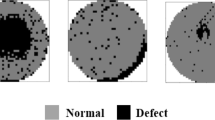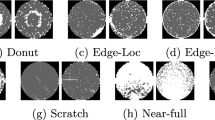Abstract
In semiconductor industry, various wafer defect patterns represent different causes of manufacturing failures. Identification of specific defect patterns is important to wafer fabrication process. Recently, many studies concentrate on developing Deep Learning algorithms such as Convolution Neural Network, most of which neglect hyper-relations among dataset. Therefore, in this work, a novel Hypergraph Convolution Network is proposed for the automatic Wafer Defect Identification (HCN-WDI). The main contributions include: (1) The detailed theoretical formulation and NP-Completeness proof of normalized cut for (hyper-)edge segmentation is firstly discussed. (2) The data augmentation techniques are applied to balance the number inequality of different patterns in wafer defect dataset WM-811K. (3) The Hyper Convolution Network is implemented as an end-to-end operator to identify wafer defect patterns and three conventional image classifiers are used as feature extractors and reference baselines for the proposed HCN-WDI model. The experimental results show that the proposed HCN-WDI model outperforms other three fine-tuning conventional image classifiers and obtains the highest \(96.44\%\) averaged classification accuracy. Besides, by comparing the results from various combinations of extracted features, it is concluded that the accuracy of the HCN-WDI model is also dependent on the quality rather than quantities of feature extraction.








Similar content being viewed by others
Data availability
The data that support the findings of this study are available from the corresponding author upon request.
Code availability
The feature extractors are available from the corresponding author upon request.
References
Bai, S., Zhang, F., & Torr, P. H. (2021). Hypergraph convolution and hypergraph attention. Pattern Recognition, 110(107), 637.
Berge, C. (1973). Graphs and hypergraphs. AGRIS.
Cheon, S., Lee, H., Kim, C. O., & Lee, S. H. (2019). Convolutional neural network for wafer surface defect classification and the detection of unknown defect class. IEEE Transactions on Semiconductor Manufacturing, 32(2), 163–170.
Chou, W., Shao, J., Chung, R., Chen, L., Chen, A., & Zhou, L. (2019). Semiconductors—The next wave: Opportunities and winning strategies for semiconductor companies.
Di Palma, F., De Nicolao, G., Miraglia, G., Pasquinetti, E., & Piccinini, F. (2005). Unsupervised spatial pattern classification of electrical-wafer-sorting maps in semiconductor manufacturing. Pattern Recognition Letters, 26(12), 1857–1865.
Feng, Y., You, H., Zhang, Z., Ji, R., & Gao, Y. (2019). Hypergraph neural networks. In Proceedings of the AAAI conference on artificial intelligence (pp 3558–3565).
Garey, M. R., & Johnson, D. S. (1979). Computers and intractability (Vol. 174). San Francisco: Freeman.
He, K., Zhang, X., Ren, S., & Sun, J. (2016). Deep residual learning for image recognition. In Proceedings of the IEEE conference on computer vision and pattern recognition (pp 770–778).
Japkowicz, N., & Stephen, S. (2002). The class imbalance problem: A systematic study. Intelligent Data Analysis, 6(5), 429–449.
Jeong, Y. S., Kim, S. J., & Jeong, M. K. (2008). Automatic identification of defect patterns in semiconductor wafer maps using spatial correlogram and dynamic time warping. IEEE Transactions on Semiconductor manufacturing, 21(4), 625–637.
Jin, C. H., Na, H. J., Piao, M., Pok, G., & Ryu, K. H. (2019). A novel DBSCAN-based defect pattern detection and classification framework for wafer bin map. IEEE Transactions on Semiconductor Manufacturing, 32(3), 286–292.
Khan, S. H., Hayat, M., Bennamoun, M., Sohel, F. A., & Togneri, R. (2017). Cost-sensitive learning of deep feature representations from imbalanced data. IEEE Transactions on Neural Networks and Learning Systems, 29(8), 3573–3587.
Krizhevsky, A., Sutskever, I., & Hinton, G. E. (2012). Imagenet classification with deep convolutional neural networks. Advances in Neural Information Processing Systems, 25.
Kyeong, K., & Kim, H. (2018). Classification of mixed-type defect patterns in wafer bin maps using convolutional neural networks. IEEE Transactions on Semiconductor Manufacturing, 31(3), 395–402.
Li, P., & Milenkovic, O. (2017). Inhomogeneous hypergraph clustering with applications. Advances in Neural Information Processing Systems, 30.
Mariani, G., Scheidegger, F., Istrate, R., Bekas, C., & Malossi, C (2018). Bagan: Data augmentation with balancing gan. arXiv:1803.09655
Milor, L. (2013). A survey of yield modeling and yield enhancement methods. IEEE Transactions on Semiconductor Manufacturing, 26(2), 196–213.
Nakazawa, T., & Kulkarni, D. V. (2018). Wafer map defect pattern classification and image retrieval using convolutional neural network. IEEE Transactions on Semiconductor Manufacturing, 31(2), 309–314.
Saqlain, M., Abbas, Q., & Lee, J. Y. (2020). A deep convolutional neural network for wafer defect identification on an imbalanced dataset in semiconductor manufacturing processes. IEEE Transactions on Semiconductor Manufacturing, 33(3), 436–444.
Saqlain, M., Jargalsaikhan, B., & Lee, J. Y. (2019). A voting ensemble classifier for wafer map defect patterns identification in semiconductor manufacturing. IEEE Transactions on Semiconductor Manufacturing, 32(2), 171–182.
Semiconductor, G. (2019). Semiconductors: As the backbone of the connected world, the industry’s future is bright. In KMPG’s 14th Annu Glob Semicond outlook Rep (pp. 1–24).
Simonyan, K., & Zisserman, A. (2014). Very deep convolutional networks for large-scale image recognition. arXiv:1409.1556
STATISTA. (2019). Monthly semiconductor sales worldwide from 2012 to 2020 (in billion u.s. dollars). Statista Gmbh: Hamburg, Germany.
Tello, G., Al-Jarrah, O. Y., Yoo, P. D., Al-Hammadi, Y., Muhaidat, S., & Lee, U. (2018). Deep-structured machine learning model for the recognition of mixed-defect patterns in semiconductor fabrication processes. IEEE Transactions on Semiconductor Manufacturing, 31(2), 315–322.
Wang, J., Yang, Z., Zhang, J., Zhang, Q., & Chien, W. T. K. (2019). Adabalgan: An improved generative adversarial network with imbalanced learning for wafer defective pattern recognition. IEEE Transactions on Semiconductor Manufacturing, 32(3), 310–319.
Wu, M. J., Jang, J. S. R., & Chen, J. L. (2014). Wafer map failure pattern recognition and similarity ranking for large-scale data sets. IEEE Transactions on Semiconductor Manufacturing, 28(1), 1–12.
Wu, Z., & Leahy, R. (1993). An optimal graph theoretic approach to data clustering: Theory and its application to image segmentation. IEEE Transactions on Pattern Analysis and Machine Intelligence, 15(11), 1101–1113.
Wu, Z., Pan, S., Chen, F., Long, G., Zhang, C., & Philip, S. Y. (2020). A comprehensive survey on graph neural networks. IEEE Transactions on Neural Networks and Learning Systems, 32(1), 4–24.
Zhang, Z., Cui, P., & Zhu, W. (2020). Deep learning on graphs: A survey. IEEE Transactions on Knowledge and Data Engineering.
Zhou, J., Cui, G., Hu, S., Zhang, Z., Yang, C., Liu, Z., Wang, L., Li, C., & Sun, M. (2020). Graph neural networks: A review of methods and applications. AI Open, 1, 57–81.
Author information
Authors and Affiliations
Corresponding author
Ethics declarations
Conflict of interest
All authors certify that they have no affiliations with or involvement in any organization or entity with any financial interest or non-financial interest in the subject matter or materials discussed in this manuscript.
Additional information
Publisher's Note
Springer Nature remains neutral with regard to jurisdictional claims in published maps and institutional affiliations.
Appendix A: Proof of NP-completeness
Appendix A: Proof of NP-completeness
Proof
To prove NP-completeness of optimal normalized cuts in hypergraph, i.e.,
Two restrictions are introduced:
-
edge weight keeps constant, i.e., \(\textrm{w}(e)=1\).
-
each hyperedge only connects two nodes.
Based on the two restrictions above, the definitions of volumes of vertex subset S and \(S^c\) can be reduced as,
Then the volume of hyperedge boundary \(\partial S\) is defined as
in which, \(\left| e \cap S \right| = \left| e \cap S^c \right| =1\) based on the two restrictions above.
Summarily, the Eq. (A1) can be converted to
It denotes that minimizing normalized cuts for hypergraph can be reduced to simple graph which is NP-complete.
According to NP-Completeness proof techniques Garey and Johnson (1979), by applying some specifications of additional restrictions on the problem \(\Pi \) which is to be proved as NP-Completeness, the modified problem with additional restrictions can be reduced to be identical another problem \(\Pi ^{\prime }\) which has been known as NP-Complete.
Therefore, the NP-completeness of the problem that minimizing normalized cuts of hypergraph has been proved.
Rights and permissions
Springer Nature or its licensor (e.g. a society or other partner) holds exclusive rights to this article under a publishing agreement with the author(s) or other rightsholder(s); author self-archiving of the accepted manuscript version of this article is solely governed by the terms of such publishing agreement and applicable law.
About this article
Cite this article
Xie, Y., Li, S., Wu, C.T. et al. A novel hypergraph convolution network for wafer defect patterns identification based on an unbalanced dataset. J Intell Manuf 35, 633–646 (2024). https://doi.org/10.1007/s10845-022-02067-z
Received:
Accepted:
Published:
Issue Date:
DOI: https://doi.org/10.1007/s10845-022-02067-z




